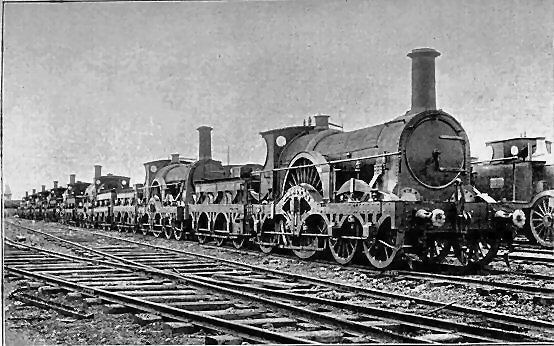Power type Steam Builder Great Western Railway Gauge 7 ft ⁄4 in (2,140 mm) | Designer Daniel Gooch Configuration 2-2-2 Leading dia. 4 ft 6 in (1.372 m) | |
 | ||
The Great Western Railway Iron Duke Class 4-2-2 was a class of 7 ft 1⁄4 in (2,140 mm) broad gauge steam locomotives for express passenger train work.
Contents
History
The prototype locomotive, Great Western, was built as a 2-2-2 locomotive in April 1846, but was soon converted to a 4-2-2 arrangement, with the leading wheels set rigidly within the sandwich framing, rather than in a separate bogie. The remainder of the class entered service between April 1847 and July 1855.
Locomotives of the Iron Duke class were extremely fast and had an estimated top speed of about 80 mph (130 km/h). They were used to haul the Flying Dutchman express train which, for several decades, was the world's fastest train. In 1852 the daily service from London Paddington Station to Exeter (194 miles or 312 km) was achieved with an average speed of 53 mph (85 km/h); with the flatter section between London and Swindon covered at an average speed of 59 mph (95 km/h).
From about 1865, the Iron Duke Class was known as the Alma Class.
In May to July 1870, three locomotives (Great Britain, Prometheus and Estaffete) were extensively rebuilt with new frames and boilers, but retaining their original names. Following these, further locomotives were built to similar specifications, entering service between August 1871 and July 1888. These new locomotives are generally referred to as the Rover class. Although these locomotives took the names of withdrawn locomotives of the original design, they were not rebuilt from them like the first three, but entirely new locomotives (though it is believed that Rover, Swallow and Balaklava may have included some parts from the earlier locomotives of those names).
Apart from the three conversions, the original locomotives were withdrawn between December 1870 and June 1884. Lord of the Isles (the last to be withdrawn) was initially preserved by the GWR at Swindon Works, but was scrapped in January 1906 owing to the pressure of space. The three conversions were withdrawn between September 1880 and October 1887, while the other locomotives to the later design were all withdrawn with the end of the GWR 7 ft 1⁄4 in (2,140 mm) broad gauge in May 1892 (except Hirondelle, which had been withdrawn in December 1890).
Many of the nameplates can be seen at the National Railway Museum and at Swindon Steam Railway Museum, while the driving wheels from Lord of the Isles can also be seen at Swindon.
2-2-2 Great Western
The prototype for this class was named the Great Western and built in 1846. Named after the railway, it was designed to show how the 2-2-2 express engines could be improved; its 8-foot-diameter (2.438 m) driving wheels were 1 foot (305 mm) larger than those of the successful Fire Fly class. It broke its leading axle after a short while in service and was subsequently rebuilt as a 4-2-2, becoming part of the Iron Duke class.
Replica
In 1985 a working replica of Iron Duke was constructed using parts from two Hunslet Austerity tanks as part of the Great Western 150 celebrations. The boiler certificate has expired so it cannot currently be steamed.
It is part of the National Railway Collection but is currently on long-term loan to the Didcot Railway Centre, which has a section of working broad gauge track.
The replica appeared in The Railway Series book Thomas and the Great Railway Show, in which it was portrayed with whiskery eyebrows and a walrus moustache.
